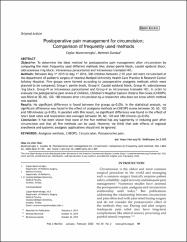| dc.contributor.author | Münevveroğlu, Çağlar | |
| dc.contributor.author | Gündüz, Mehmet | |
| dc.date.accessioned | 2020-05-14T05:48:47Z | |
| dc.date.available | 2020-05-14T05:48:47Z | |
| dc.date.issued | 2020 | en_US |
| dc.identifier.citation | Münevveroğlu, Ç. ve Gündüz, M. (2020). Postoperative pain management for circumcision; Comparison of frequently used methods. Pakistan Journal of Medical Sciences, 36(2), 91-95. https://dx.doi.org/10.12669/pjms.36.2.505 | en_US |
| dc.identifier.issn | 1682-024X | |
| dc.identifier.uri | https://hdl.handle.net/20.500.12511/5223 | |
| dc.identifier.uri | https://dx.doi.org/10.12669/pjms.36.2.505 | |
| dc.description.abstract | Objective: To determine the ideal method for postoperative pain management after circumcision by comparing the most frequently used different methods like; dorsal penile block, caudal epidural block, subcutaneous ring block, intravenous paracetamol and intravenous tramadol HCl.Methods: Between May 1st 2015 to May 1st 2016, 500 children between 2-10 year old were circumcised at the department of pediatric surgery of Istanbul Medipol University Health Care Practice & Research Center Sefakoy Hospital. Five groups were formed according to postoperative analgesia methods which were planned to be compared; Group-I. penile block, Group-II. Caudal epidural block, Group-III. subcutaneous ring block, Group-IV as intravenous paracetamol and Group-V as intravenous tramadol HCl. In order to evaluate the postoperative pain levels of children, Children's Hospital Eastern Ontario Pain Scale (CHEOPS) was filled at 30, 60, 120, 180 minutes after circumcision by a researcher who does not know which method was applied.Results: No significant difference is found between the groups (p>0.05). In the statistical analysis, no significant difference was found in the effect of analgesia methods on CHEOPS scores between 30, 60, 120 and 180 minutes (p>0.05). In parallel with this result, no significant difference was found in the effect of heart beat rates and respiration rate averages between 30, 60, 120 and 180 minutes (p>0.05).Conclusion: It has been shown that none of the five method has any superiority in reducing pain after circumcision and that all five methods can be used. However, we think that side effects of regional anesthesia and systemic analgesic applications should not be ignored. | en_US |
| dc.language.iso | eng | en_US |
| dc.publisher | Professional Medical Publications | en_US |
| dc.rights | info:eu-repo/semantics/openAccess | en_US |
| dc.rights | Attribution 3.0 Unported | * |
| dc.rights.uri | https://creativecommons.org/licenses/by/3.0/ | * |
| dc.subject | Analgesia Methods | en_US |
| dc.subject | CHEOPS | en_US |
| dc.subject | Circumcision | en_US |
| dc.subject | Postoperative Pain | en_US |
| dc.title | Postoperative pain management for circumcision; Comparison of frequently used methods | en_US |
| dc.type | article | en_US |
| dc.relation.ispartof | Pakistan Journal of Medical Sciences | en_US |
| dc.department | İstanbul Medipol Üniversitesi, Tıp Fakültesi, Cerrahi Tıp Bilimleri Bölümü, Çocuk Cerrahisi Ana Bilim Dalı | en_US |
| dc.department | İstanbul Medipol Üniversitesi, Tıp Fakültesi, Dahili Tıp Bilimleri Bölümü, Çocuk Sağlığı ve Hastalıkları Ana Bilim Dalı | en_US |
| dc.authorid | 0000-0003-4479-3404 | en_US |
| dc.identifier.volume | 36 | en_US |
| dc.identifier.issue | 2 | en_US |
| dc.identifier.startpage | 91 | en_US |
| dc.identifier.endpage | 95 | en_US |
| dc.relation.publicationcategory | Makale - Uluslararası Hakemli Dergi - Kurum Öğretim Elemanı | en_US |
| dc.identifier.doi | 10.12669/pjms.36.2.505 | en_US |
| dc.identifier.wosquality | Q4 | en_US |
| dc.identifier.scopusquality | Q3 | en_US |




















